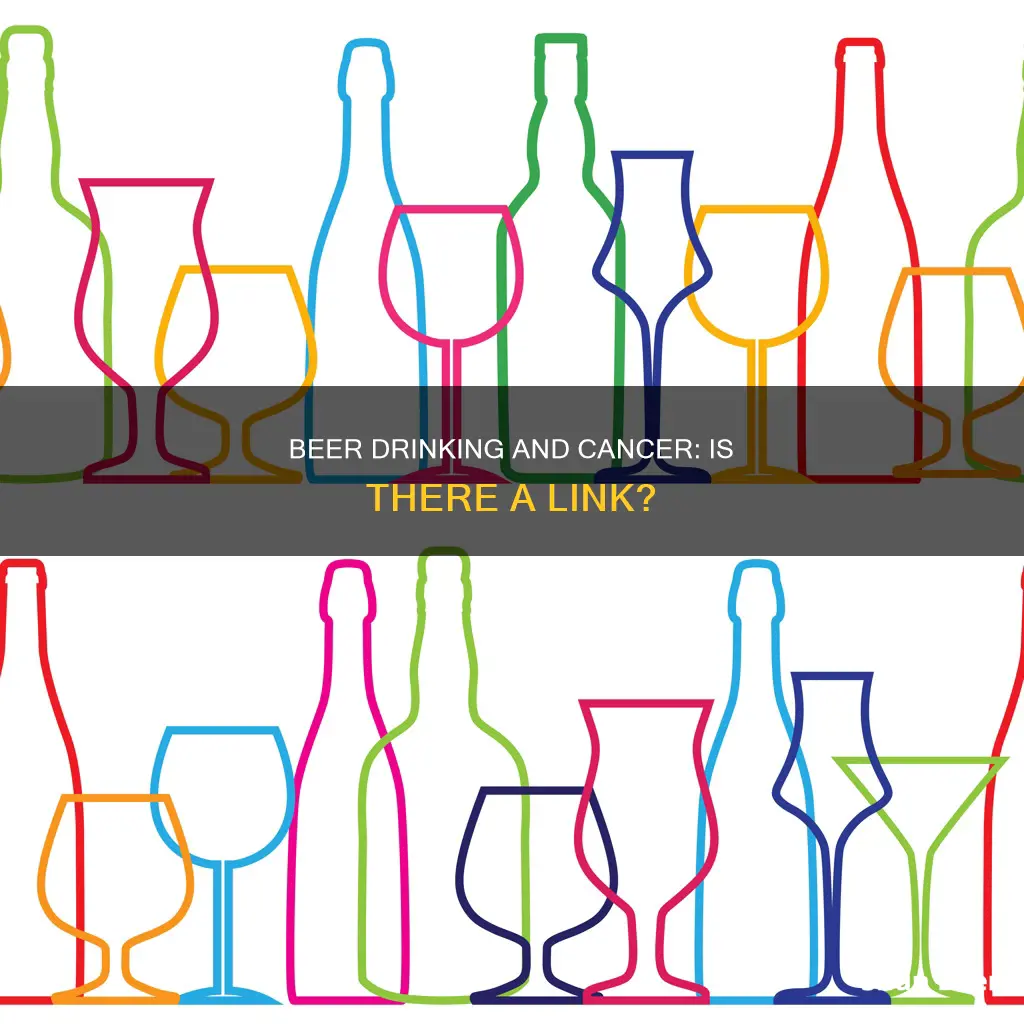
Alcohol consumption is a significant risk factor for cancer, with about 5.5% of all new cancer diagnoses and 5.8% of cancer-related deaths attributed to drinking. According to the National Cancer Institute, alcohol drinking can cause several types of cancer, and the risk increases with the amount of alcohol consumed. Beer, like all alcoholic drinks, contains ethanol, which the body breaks down into acetaldehyde, a toxic chemical that damages DNA and proteins and impairs the absorption of vital nutrients. This damage to cells and hormonal changes caused by alcohol consumption increases the risk of various cancers, including head and neck cancer, esophageal cancer, liver cancer, breast cancer, and colorectal cancer. The combination of drinking and smoking further exacerbates the risk of certain cancers. While the specific mechanisms by which alcohol affects cancer risk are not fully understood, the evidence consistently indicates that alcohol consumption is detrimental to health and increases the likelihood of developing cancer.
| Characteristics | Values |
|---|---|
| Cancer risk | Drinking alcohol increases the risk of developing several types of cancer. Alcohol is estimated to account for 6% of cancer cases in the US. |
| Cancer types | Mouth, throat, voice box, oesophagus, liver, colon, rectum, breast, stomach, and pancreas |
| Cancer risk factors | The more alcohol a person drinks, the higher their risk of developing cancer. Heavy drinking, binge drinking, and drinking combined with smoking all increase cancer risk. |
| Mechanism | Alcohol is converted into acetaldehyde, a toxic chemical that can damage DNA and cause cancer. Alcohol also causes oxidative stress and hormonal changes that can increase cancer risk. |
| Prevention | The best way to prevent alcohol-related cancer is to avoid drinking alcohol. For those who choose to drink, limiting consumption to 1-2 drinks per day is recommended. |
What You'll Learn

Beer drinking increases the risk of several cancers
Drinking beer and other alcoholic beverages is linked to an increased risk of developing several types of cancer. Alcohol consumption accounts for about 6% of all cancers and 4% of all cancer-related deaths in the United States. While the public is largely unaware of this link, it is important to understand the risks associated with drinking beer and other alcoholic drinks.
Types of Cancers Associated with Alcohol Consumption
According to various studies, drinking beer and other alcoholic beverages increases the risk of the following types of cancers:
- Oral cancer: Alcohol use raises the risk of cancer in the oral cavity or mouth.
- Laryngeal cancer: Alcohol consumption is linked to an increased risk of cancer in the larynx or voice box.
- Esophageal cancer: Drinking alcohol is associated with a higher risk of cancer in the esophagus, the tube that connects the throat to the stomach.
- Liver cancer: Long-term and heavy alcohol use can damage the liver, leading to inflammation and scarring, which increases the risk of liver cancer.
- Colon and rectal cancer: Alcohol consumption is linked to a higher risk of cancers in the colon and rectum.
- Breast cancer: Even small amounts of alcohol can increase the risk of breast cancer, possibly due to increased estrogen levels in the body.
- Stomach and pancreatic cancers: Studies show that drinking three or more alcoholic drinks per day increases the risk of these cancers.
- Prostate cancer: Alcohol consumption may also increase the risk of prostate cancer.
Mechanisms by which Alcohol Increases Cancer Risk
There are several ways in which alcohol consumption contributes to the development of cancer:
- DNA damage: Alcohol is broken down by the body into acetaldehyde, a toxic chemical that can damage DNA and increase the risk of cancer.
- Oxidative stress: Alcohol breakdown creates free radicals or reactive oxygen species that damage cells and DNA, leading to oxidative stress.
- Hormonal changes: Alcohol affects the levels of hormones like estrogen and insulin, which can increase cell division and the chance of cancer development.
- Changes to cells in the mouth and throat: Alcohol makes it easier for cells in these areas to absorb harmful chemicals, such as those found in tobacco smoke.
- Reduced nutrient absorption: Alcohol interferes with the absorption of vital nutrients like vitamins and minerals that protect the body from cancer.
- Weight gain: Excess alcohol consumption contributes to weight gain, which is a known risk factor for over 12 types of cancer.
Reducing Cancer Risk
The best way to reduce the risk of alcohol-related cancers is to abstain from drinking completely. However, for those who choose to drink, moderation is key. The recommended limits are no more than two drinks per day for men and one drink per day for women. Cutting down on alcohol consumption can have a positive impact on reducing cancer risk.
Organic Beer and Gout: Is It Safe to Drink?
You may want to see also

Alcohol is converted to a toxic chemical in the body
Alcohol is converted into a toxic chemical called acetaldehyde in the body. This chemical is a known carcinogen, which means it can cause cancer. Acetaldehyde damages DNA and proteins, and it can also stop cells from repairing this damage, allowing cancerous cells to grow. This damage to DNA can lead to mutations that are associated with cancer.
The process of breaking down alcohol creates other harmful molecules called free radicals, which cause oxidative stress by damaging DNA, proteins, lipids, and cells. This oxidative stress can lead to damage inside the cells that may increase the risk of cancer.
Alcohol also affects hormone levels, such as oestrogen and insulin. These hormones act as messengers, and higher levels can make cells divide more often, increasing the chance that cancer will develop.
In addition, alcohol can make it easier for cells in the mouth and throat to absorb harmful chemicals, such as those found in tobacco smoke. This may be why drinking alcohol increases the risk of mouth and throat cancers.
The combination of drinking alcohol and smoking is much more likely to cause cancers in the mouth and throat than smoking or drinking alone. Alcohol may also slow down the body's ability to break down and get rid of some harmful chemicals, further increasing the risk of cancer.
Drinking Beer at Sheetz: What You Need to Know
You may want to see also

Alcohol affects hormone levels
Alcohol can affect the body's hormone levels in several ways, leading to serious medical consequences. Here are some key ways in which alcohol can impact hormone levels:
- Impaired Hormone Gland Functions: Alcohol can impair the functions of glands that release hormones, disrupting the body's hormonal balance. This interference can affect various bodily functions, including growth, development, blood pressure regulation, bone mass maintenance, and energy production.
- Increased Estrogen Levels: Alcohol consumption can lead to increased levels of estrogen in the body. While this may have some positive effects for postmenopausal women, it is also associated with an increased risk of breast cancer, especially before menopause.
- Reproductive Dysfunction: Chronic alcohol consumption can interfere with the normal functioning of the testes and ovaries, leading to hormonal deficiencies, sexual dysfunction, and infertility in both men and women. In women, it can cause irregular menstrual cycles, missed periods, and reduced fertility.
- Blood Sugar Imbalance: Alcohol interferes with the body's glucose levels and the hormones that regulate them, such as insulin and glucagon. This can lead to temporary hypoglycemia, impaired hormonal response to hypoglycemia, and an increased risk of diabetes.
- Calcium Metabolism and Bone Structure: Alcohol can disrupt calcium metabolism and bone structure by interfering with hormones like parathyroid hormone, vitamin D-derived hormones, and calcitonin. This can result in calcium deficiency and an increased risk of bone diseases like osteoporosis.
- Increased Cortisol Production: Alcohol consumption can increase the body's production of cortisol, which can have short-term benefits but can negatively impact long-term functions like bone growth, digestion, reproduction, and wound repair.
Ethanol Distillation Simplified: Beer Stripper Method
You may want to see also

Alcohol and tobacco have a combined effect
Alcohol may also change the way toxic chemicals in tobacco smoke are broken down in the body, making them even more harmful. For example, when we drink alcohol, our bodies turn it into a chemical called acetaldehyde, which can damage our cells and stop them from repairing this damage.
People who smoke and drink alcohol are at a higher risk of mouth and upper throat cancers than those who only smoke or drink. The risk of these cancers is substantially higher among those who consume alcohol and also use tobacco. The effect of combined exposure to alcohol and tobacco on the risk of oral and pharyngeal cancer is multiplicative, meaning that the risk of combined exposure is the product of the increases in risk associated with each habit.
In addition, people who inherit a deficiency in an enzyme that metabolises alcohol have been found to have substantially increased risks of oesophageal squamous cell carcinoma if they consume alcohol.
Hiking and Beer: A Good Mix?
You may want to see also

Alcohol affects nutrient absorption
Alcohol can affect the absorption of nutrients in the body in several ways. Firstly, it can impair the body's ability to break down and absorb various nutrients, including vitamin A, vitamins in the B complex (such as folate), vitamin C, vitamin D, vitamin E, and carotenoids. This is due to the inhibitory effect of ethanol on the absorption of these nutrients in the small intestine.
Secondly, alcohol can alter the composition of the microbiota in the intestine, causing bacterial overgrowth. This can further disrupt the normal absorption of nutrients.
Thirdly, alcohol can increase the levels of certain hormones, such as oestrogen and insulin, which can affect nutrient absorption.
Finally, alcohol can also affect the digestion of nutrients by inhibiting certain enzymes in the body.
Overall, alcohol consumption, even at low to moderate dosages, can have a significant impact on nutrient absorption and transport in the body, leading to malnutrition and various nutrient deficiencies.
Beer and Anemia: Is It Safe to Drink?
You may want to see also
Frequently asked questions
Yes, drinking beer can cause cancer. Alcoholic beverages, including beer, contain ethanol, which the body breaks down into acetaldehyde, a toxic chemical and known carcinogen.
When you drink alcohol, your body breaks it down into a chemical called acetaldehyde that can damage your DNA and stop your cells from repairing this damage. This can allow cancerous cells to grow.
Drinking beer and other alcoholic beverages is linked to an increased risk of oral cancer, laryngeal cancer, esophageal cancer, liver cancer, colon cancer, rectal cancer, and breast cancer.
There is no safe amount of alcohol when it comes to cancer risk. The more you drink, the higher your risk of developing cancer. However, according to dietary guidelines, it is recommended that men have no more than two drinks per day and women have no more than one drink per day.
While some studies suggest that compounds in red wine may offer cardiovascular benefits, there is no clear evidence that drinking alcohol has any health benefits. The risks of cancer and other health issues associated with drinking alcohol outweigh any potential benefits.







